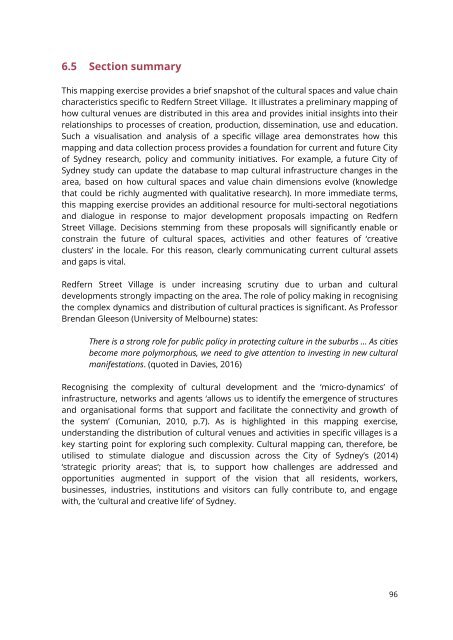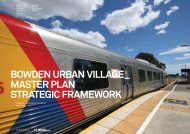MAPPING CULTURE
Mapping-Culture-Venues-and-Infrastructure-in-the-City-of-Sydney
Mapping-Culture-Venues-and-Infrastructure-in-the-City-of-Sydney
You also want an ePaper? Increase the reach of your titles
YUMPU automatically turns print PDFs into web optimized ePapers that Google loves.
6.5 Section summary<br />
This mapping exercise provides a brief snapshot of the cultural spaces and value chain<br />
characteristics specific to Redfern Street Village. It illustrates a preliminary mapping of<br />
how cultural venues are distributed in this area and provides initial insights into their<br />
relationships to processes of creation, production, dissemination, use and education.<br />
Such a visualisation and analysis of a specific village area demonstrates how this<br />
mapping and data collection process provides a foundation for current and future City<br />
of Sydney research, policy and community initiatives. For example, a future City of<br />
Sydney study can update the database to map cultural infrastructure changes in the<br />
area, based on how cultural spaces and value chain dimensions evolve (knowledge<br />
that could be richly augmented with qualitative research). In more immediate terms,<br />
this mapping exercise provides an additional resource for multi-sectoral negotiations<br />
and dialogue in response to major development proposals impacting on Redfern<br />
Street Village. Decisions stemming from these proposals will significantly enable or<br />
constrain the future of cultural spaces, activities and other features of ‘creative<br />
clusters’ in the locale. For this reason, clearly communicating current cultural assets<br />
and gaps is vital.<br />
Redfern Street Village is under increasing scrutiny due to urban and cultural<br />
developments strongly impacting on the area. The role of policy making in recognising<br />
the complex dynamics and distribution of cultural practices is significant. As Professor<br />
Brendan Gleeson (University of Melbourne) states:<br />
There is a strong role for public policy in protecting culture in the suburbs … As cities<br />
become more polymorphous, we need to give attention to investing in new cultural<br />
manifestations . (quoted in Davies, 2016)<br />
Recognising the complexity of cultural development and the ‘micro-dynamics’ of<br />
infrastructure, networks and agents ‘allows us to identify the emergence of structures<br />
and organisational forms that support and facilitate the connectivity and growth of<br />
the system’ (Comunian, 2010, p.7). As is highlighted in this mapping exercise,<br />
understanding the distribution of cultural venues and activities in specific villages is a<br />
key starting point for exploring such complexity. Cultural mapping can, therefore, be<br />
utilised to stimulate dialogue and discussion across the City of Sydney’s (2014)<br />
‘strategic priority areas’; that is, to support how challenges are addressed and<br />
opportunities augmented in support of the vision that all residents, workers,<br />
businesses, industries, institutions and visitors can fully contribute to, and engage<br />
with, the ‘cultural and creative life’ of Sydney.<br />
96



